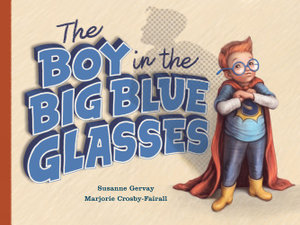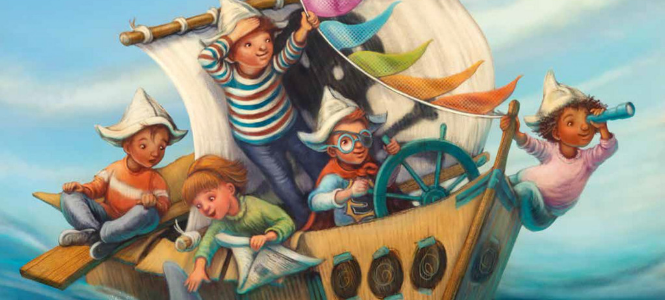Did you know that one in five kids have an undetected vision problem?
Susanne Gervay did – that’s what inspired her to write The Boy in the Big Blue Glasses, a beautiful new picture book about a little boy who doesn’t like his new glasses.
Today, Susanne is on the blog to answer some questions about her book – scroll down to see what she said!
Tell us about your book!
SG: The Boy in the Big Blue Glasses is a swashbuckling adventure, where cardboard boxes become googly-eyed fish and even a pirate ship. Watch out for sharks as Sammy, the brave captain leads his crew of girls and boys across the seas. Sammy’s a hero, like all kids, until the day he feels different. He gets glasses. His parents, teacher, family are happy for Sammy, because life is no longer blurry. So, the great miscommunication begins. The superhero is still heroic, funny, determined as he uses clever tactics and quick thinking to stay on top. But he’s losing his special powers, as he feels no-one hears or sees him at home and at school. Sammy’s self-esteem plummets, until there’s a crisis where Sammy is alone, wearing his big blue glasses.
Things have to change. Through humour, self-realisation and the indomitable spirit of kids, Sammy wins the challenge of change. Wearing his glasses, the heroic captain returns, leading his pirate crew on new adventures.
Where did you get the inspiration for this story?
SG: When my little red-headed grandson didn’t want to wear his glasses, because “no-one could see him,” my spirits dropped. I’ve worn glasses since I was a child. It was embarrassing, difficult to manage glasses and made me feel different. Every photo of me as a child, teen and young adult is without glasses. As an adult I wear my glasses with pride, but it took a long time to get there.
It’s insidious when your vision becomes compromised. A child just accepts the world looks the same for everyone – a blur. It’s easy to get misjudged as clumsy, disruptive, uncooperative, a slow learner, uncoordinated at sport, when it’s just that a child’s vision is impaired. If they are lucky, their vision problems are identified, and they get glasses. But glasses are hard to manage. You lose them. Break them. Crack them. They can hurt the back of your ears, dig into the bridge on your nose. There are the eye tests, which take forever and the drops sting. Swimming without glasses means you can’t see someone waving at you from the shore.
Some kids can be mean about them. Make jokes and all that rough and tumble of school, can focus on your glasses. It often isn’t about the glasses, but something that they can point too to make you a scapegoat.
I wrote The Boy in the Big Blue Glasses because it’s essential that kids have their vision problems identified and wear their glasses. They have to feel good about wearing glasses and other children need to accept the difference, because children are developing their sense of self and are vulnerable. Glasses or any difference needs to empower a child, as it’s part of who they are.
This book has some gorgeous illustrations by Marjorie Crosby-Fairall. What was it like to see Marjorie bring the story to life?
SG: My heart jumped with joy when I saw Sammy in his big blue glasses flying off the back cover saving his friend George from the jaws of a shark. It was Peter Pan, Tintin, Indiana Jones, Narnia’s Peter, Susan. Edmund and Lucy, on a rollicking adventure of imagination where kids are superheroes.
The 1950’s retro style of illustration, with the Superman backdrops and contemporary school kids, is not only innovative but takes us on Sammy’s emotional rollercoaster of battling for his identity. There’s a lump in my throat when Sammy takes off his glasses and refuses to cry – “I don’t cry, because I’m a superhero.” I want to jump into that page and hug Sammy, because he really is a superhero like all kids. They’re brave.
Marjorie has illustrated with such intention. The children make sea-life cardboard hats with googly eyes that they wear in the classroom. The imagery cleverly relates to the teasing Sammy experiences, and when he takes off his glasses, the blurred images of googly eyed sea-life link into the imagery in both the story and illustrations throughout the book.
Marjorie and I worked together on The Boy in the Big Blue Glasses in a beautiful experience of collaboration. The illustrations are gorgeous.
How important is it to have kids with vision problems represented in children’s books?
SG: Harry Potter’s big black glasses identified him as a nerd. While he became a superhero fighting evil to become a winner, the glasses were the symbol of a ‘loser’. I love Harry Potter, but it is time for kids who wear glasses to lose this stereotypical identification as the ‘nerd’. That’s what The Boy in the Big Blue Glasses does. Sammy is ‘cool’, a leader, a mate, with so much to explore as he grows up, when he faces the great challenge of glasses.
It’s really important that kids with or without glasses, are drawn into the story and what it means. When Sammy takes off his glasses, he becomes visually impaired. It’s very hard to be a superhero or just grow up when the world is a blur. While The Boy in the Big Blue Glasses engages kids in story, it opens many questions for children and adults to explore together. Questions like – How would you feel wearing glasses? What’s it like going to the eye doctor/optometrist? Why doesn’t Sammy’s family understand how he feels? What would you do if your friend got glasses?
What message do you hope kids will take away with them from The Boy in the Big Blue Glasses?
SG: Kids feel so much but have so little experience to navigate the complexities of growing up. Sammy tries to work out why adults behave as they do. Why they can’t hear him. He uses all his skills from defiance, clever tactics to hide his glasses, bravery, but nothing works until he’s hiding and scared.
I hope kids realise that parents and adults care, but they sometimes can’t hear what kids are telling them or are feeling. I hope adults realise that too from The Boy in the Big Blue Glasses. Story helps unlock communication pathways to help kids find the answers they need.
I hope kids who wear glasses accept it as part of them and that others realise that everyone is different and it is all right to wear glasses.
This book brings awareness of the importance of detecting visual impairment and the processes involved from the optometrist chair with all its paraphernalia, visits to the eye doctor and eye checks, and the impact of not wearing them.
I am deeply moved that The Feelix Library and The Braille House are transcribing The Boy in the Big Blue Glasses into Braille and that it is part of the Good Vision For Life campaign to for vision care for children. Currently 1 in 5 children have unidentified vision problems and The Boy in the Big Blue Glasses is part of their awareness raising campaign.
What was the most challenging thing about writing this book?
SG: Authors often have worthy ideas. I wanted to write this book for a long time, but I didn’t want to be worthy. So I fiddled and failed, until I found the voice of my superhero Sammy. Then the story came, because it was a story of real kids and how they felt and reacted.
Do you have any other favourite children’s books that deal with the issue of vision problems?
SG: The Patch by Justina Chen Headley, illustrated by Mitch Vane.
Thanks Susanne!

The Boy in the Big Blue Glasses
Sam doesn't like his new glasses.
They make his ears hurt. His parents say he looks handsome in them. But Sam just wants to look like himself. His teacher doesn't recognize him; she says he must be a new superhero. But Sam doesn't want to be a superhero. He just wants to be himself...








 Learning To Read With The School Of Monsters by Sally Rippin
Learning To Read With The School Of Monsters by Sally Rippin  Ten Terrifying Questions with the creators of Wylah the Koorie Warrior!
Ten Terrifying Questions with the creators of Wylah the Koorie Warrior!  Let’s make ice blocks with Bluey and Bingo!
Let’s make ice blocks with Bluey and Bingo!
Comments
No comments